
Super Mario World, known in Japanese marketing as Super Mario World: Super Mario Bros. 4, is a platform game developed by Nintendo EAD and published by Nintendo for the Super Nintendo Entertainment System (SNES). It was released in Japan in 1990, North America in 1991 and Europe and Australia in 1992. The player controls Mario on his quest to save Princess Peach and Dinosaur Land from the series' antagonist Bowser and the Koopalings. The gameplay is similar to that of earlier Super Mario games; players control Mario through a series of levels in which the goal is to reach the goalpost at the end.

Super Mario World 2: Yoshi's Island is a 1995 platform game developed and published by Nintendo for the Super Nintendo Entertainment System (SNES). It is the sequel follow-up to Super Mario World. The player controls Yoshi, a friendly dinosaur, on a quest to reunite baby Mario with his brother Luigi, who has been kidnapped by Kamek. As a Super Mario series platformer, Yoshi runs and jumps to reach the end of the level while solving puzzles and collecting items with Mario's help. The game has a hand-drawn aesthetic and was the first in the franchise to have Yoshi as its main character, where it introduces his signature flutter jump and egg spawning abilities.
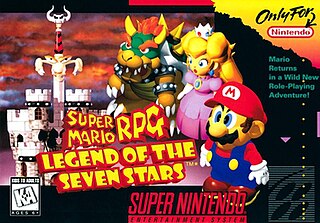
Super Mario RPG: Legend of the Seven Stars is a 1996 role-playing game developed by Square and published by Nintendo for the Super Nintendo Entertainment System (SNES). It was the final Mario game published for the SNES. The game was directed by Chihiro Fujioka and Yoshihiko Maekawa, produced by Shigeru Miyamoto, and scored by Yoko Shimomura.

Earthworm Jim is a 1994 run and gun platform game developed by Shiny Entertainment, featuring an earthworm named Jim, who wears a robotic suit and battles the forces of evil. The game was released for the Sega Genesis and Super Nintendo Entertainment System, before being subsequently ported to a number of other video game consoles.

Donkey Kong Country is a 1994 platform game developed by Rare and published by Nintendo for the Super Nintendo Entertainment System (SNES). It is a reboot of Nintendo's Donkey Kong franchise and follows the gorilla Donkey Kong and his nephew Diddy Kong as they set out to recover their stolen banana hoard from the crocodile King K. Rool and his army, the Kremlings. The single-player traverses 40 side-scrolling levels as they jump between platforms and avoid obstacles. They collect items, ride minecarts and animals, defeat enemies and bosses, and find secret bonus stages. In multiplayer modes, two players work cooperatively or race each other.

Donkey Kong Land is a 1995 platform game developed by Rare and published by Nintendo for the Game Boy. It condenses the side-scrolling gameplay of the Super Nintendo Entertainment System (SNES) game Donkey Kong Country (1994) for the handheld Game Boy with different level design and boss fights. The player controls the gorilla Donkey Kong and his nephew Diddy Kong as they defeat enemies and collect items across 30 levels to recover their stolen banana hoard from the crocodile King K. Rool.
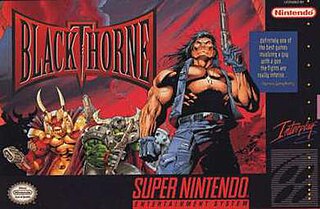
Blackthorne is a cinematic platform game developed by Blizzard Entertainment. It was released for the Super NES and MS-DOS in 1994. The cover art for the SNES version was drawn by Jim Lee. The following year, Blackthorne was released for the Sega 32X with additional content. In 2013, Blizzard released the game for free on their Battle.net PC client. In celebration of the company's 30th anniversary, Blackthorne was re-released for Nintendo Switch, PlayStation 4, Windows, and Xbox One as part of the Blizzard Arcade Collection in February 2021.

Mario Is Missing! is a 1993 educational game developed and published by The Software Toolworks for MS-DOS, Nintendo Entertainment System, and Super Nintendo Entertainment System, later released on Macintosh in 1994. The player controls Luigi, who must travel around the world to find and return stolen treasures as part of a quest to find his brother, Mario, who has been captured by Bowser. Mario Is Missing!, part of a series of educational Mario games, was Luigi's second starring role in a video game, following the 1990 Game Watch game Luigi's Hammer Toss and preceding the 2001 GameCube game Luigi's Mansion.
Bonk, known as PC-Genjin in Japan and as PC Kid or BC Kid in PAL territories, is a video game character and former mascot for NEC's PC Engine/TurboGrafx-16 video game console. Three platform games featuring the character appeared on the PC Engine/TurboGrafx-16, as well as two spin-offs featuring Air Zonk. The protagonist is a bald caveman named Bonk who attacks using his comically large head.

Hagane: The Final Conflict is a 1994 action-platform video game developed by CAProduction and published by Red Entertainment and Hudson for the Super Nintendo Entertainment System. The player takes on the role of a ninja cyborg named Hagane on his path to take revenge on an opposing ninja faction. The game combines traditional Japanese ninja and samurai aesthetics with a futuristic setting. The player has a wide variety of weapons, moves, and attacks at their disposal to defeat enemies and progress through the game. Hagane released to positive reception, and was compared favorably to classic side-scrolling action games. Reviewers praised the controls, art design, and challenge but criticized the quality of the graphics and sound.
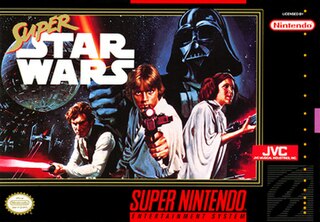
Super Star Wars is a 1992 action video game developed by LucasArts and Sculptured Software for the Super Nintendo Entertainment System. It is based on the 1977 film Star Wars. It was released by JVC Musical Industries in Japan and Nintendo in North America in 1992 and Europe in 1993. The game was followed by two sequels based on the subsequent Star Wars films, Super Star Wars: The Empire Strikes Back (1993) and Super Star Wars: Return of the Jedi (1994). The game was re-released in November 1996 as part of Nintendo's Player's Choice series. It was released on the Wii’s Virtual Console by LucasArts in 2009.

Mega Man X is an action-platform game developed and published by Capcom for the Super Nintendo Entertainment System. It was the first Mega Man game for the 16-bit console and the first game in the Mega Man X series, a spin-off to the original Mega Man series that began on the Super NES's predecessor, the Nintendo Entertainment System. Mega Man X was released in Japan on December 17, 1993 and was released in both North America and Europe the following year. Taking place a century after the original Mega Man series, Mega Man X is set in a futuristic world populated by both humans and "Reploids", robots capable of thinking, feeling, and growing like their human creators. Because of these complex attributes, many Reploids are prone to destructive, renegade activity and are thereafter referred to as "Mavericks". The plot of the game follows the protagonist X, an android member of a military task force called the "Maverick Hunters". With the help of his partner Zero, X must thwart the plans of Sigma, a powerful Maverick leader wishing to bring about human extinction.

Mega Man X3, known as Rockman X3 (ロックマンX3) in Japan, is a video game released by Capcom for the Super Nintendo Entertainment System (SNES). The game was originally released in Japan on December 1, 1995, and later in North American and PAL regions in 1996. It is the third game in the Mega Man X series and the last to appear on the SNES. Mega Man X3 takes place in a fictional future in which the world is populated by humans and intelligent robots called "Reploids". Like their human creators, some Reploids involve themselves in destructive crime and are labelled as "Mavericks". After twice defeating the Maverick leader Sigma, the heroes X and Zero must battle a Reploid scientist named Dr. Doppler and his utopia of Maverick followers.

Bonk's Revenge, known as PC-Genjin 2 in Japan and PC Kid 2 in Europe, is a 2D platformer set in prehistory, originally for the PC Engine/TurboGrafx-16 console, created in 1991 by the Red Company for Hudson Soft, and licensed by NEC. This is the second title in the Bonk series, and was re-released for the TurboGrafx-16 in 1992 on the Gate of Thunder 4-in-1 game CD-ROM. A completely different game with the same name appeared on the Game Boy, whereas the original version was re-released for Wii Virtual Console and on the Japanese PlayStation Store. It was also released in Japan on Windows Store on December 13, 2013, and on Wii U Virtual Console on March 12, 2014. The title is also playable on the Turbografx-16/PC Engine Mini Console.

Bonk's Adventure, known as PC Genjin in Japan and BC Kid in Europe, is a scrolling platform game developed by Red Company and Atlus and released in 1989 in Japan and 1990 in North America for the PC Engine/TurboGrafx-16. The Japanese title PC Genjin is a play on the system's original name, PC Engine, with the European title PC Kid similarly referencing the system's name. The first game in the Bonk series, it was followed by two more games for the TurboGrafx-16 before branching out to other platforms.

Jurassic Park 2: The Chaos Continues is a 1994 video game and a non-canonical continuation of the Jurassic Park series, developed and published by Ocean Software for the Super Nintendo Entertainment System (SNES). It is a sequel to the SNES game Jurassic Park.
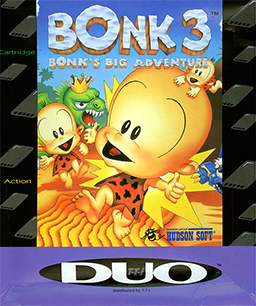
Bonk 3: Bonk's Big Adventure is an action video game released for the TurboGrafx-16 in 1993, the third game in the Bonk video game series.

Super Mario All-Stars is a 1993 compilation of platform games for the Super Nintendo Entertainment System (SNES). It contains remakes of Nintendo's four Super Mario games released for the Nintendo Entertainment System (NES) and the Famicom Disk System: Super Mario Bros. (1985), Super Mario Bros.: The Lost Levels (1986), Super Mario Bros. 2 (1988), and Super Mario Bros. 3 (1988). As in the original games, players control the Italian plumber Mario and his brother Luigi through themed worlds, collecting power-ups, avoiding obstacles, and finding secrets. The remakes feature updated graphics—including the addition of parallax scrolling—and music, modified game physics, a save feature, and bug fixes.

Super Genjin 2 is a 1995 2D platform video game by Hudson Soft for Super Famicom. It is the sequel to Super Bonk and the fifth game in the Bonk series, and the second platform game in the series never to be released outside Japan.
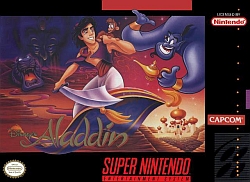
Disney's Aladdin is a 1993 platform game developed and published by Capcom for the Super Nintendo Entertainment System, based on the 1992 animated Disney film of the same name. Disney's Aladdin is a 2D side-scrolling video game in which the player controls Aladdin and his monkey Abu. It was designed by Shinji Mikami.


















